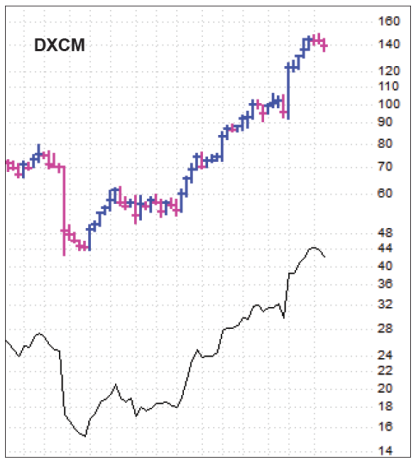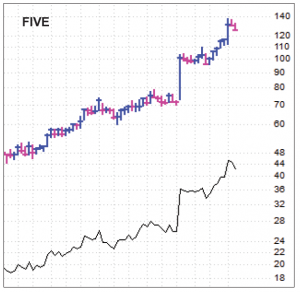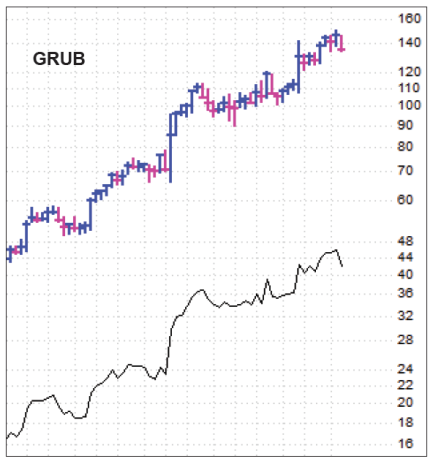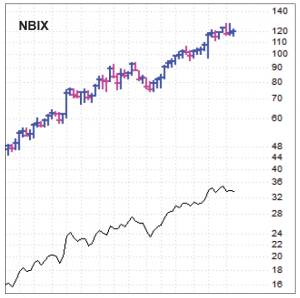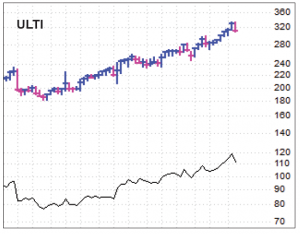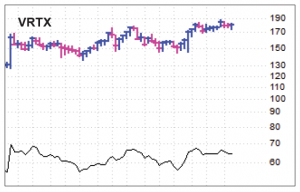September has been tricky and tedious for growth stocks, with lots of volatility and some high-volume selloffs. It’s fair to say the evidence has worsened a bit, and we’ve placed a couple of stocks on hold and raised some mental stops.
That said, the majority of evidence is still bullish, very few growth stocks have actually broken down and the market’s trends are still positive. Net-net, then, we’re still mostly bullish, but are keeping our eyes open should things change.
In tonight’s issue, we introduce our new Real Money Index, which is replacing the Two-Second Indicator on page 8; we think it will help us lean against the wind in many circumstances. (We’ll still be following the Two-Second Indicator in house.) And we also take a deep dive into all of our stocks, letting you know what we’re thinking as many have consolidated of late.
Cabot Growth Investor 1403
[premium_html_toc post_id="160297"]
Gusts of Wind, but No Rain Yet
At the end of August, there were a lot of growth stocks (and growth-oriented indexes) extended to the upside, some near-term sentiment measures were a bit giddy and we were heading into September, a month that frequently offers its fair share of turbulence.
Sure enough, starting the second day of the month, growth stocks took a multi-day hit. Then, after a nice bounce for the leaders, the sellers showed up again last week, taking profits in high-flyers and rotating into other areas of the market. But so far this week, growth stocks have perked back up!
With all the volatility and tediousness, what should you be doing? Not much, at least not yet. It’s fair to say the evidence has worsened a bit—more individual stocks are showing iffy action, and growth-oriented indexes like the Nasdaq and small caps are lagging—so we’ve placed a couple of stocks on Hold and raised some mental stops. We’re also content to keep our modest cash position on the sideline.
But that’s as cautious as we’re getting right now, and the reason why is simple: There have been very few legitimate breakdowns among leading growth stocks, which means the vast majority are still in firm uptrends. We’re not going to argue with that!
Thus, we’ve seen a couple strong gusts of wind and even some darkening skies that have caused us to close up a couple of windows. But when it comes to growth stocks and the overall market, there’s been no rain yet. All told, we haven’t made any new buys or sells so far this month in the Model Portfolio.
Looking ahead, we remain open to anything, especially in the short term—let’s not forget many growth stocks had great runs not just in August but going back many months or longer. A deeper base-building effort and/or a sustained rotation into more cyclical titles is possible. We’re keeping our eyes on those areas should new leadership emerge.
But with the action in the leaders still acceptable and all the evidence pointing toward the overall bull market continuing in the months ahead, we advise sticking with a heavily invested stance.
[highlight_box]WHAT TO DO NOW: Remain bullish and also flexible. We’ve stood pat in the Model Portfolio with nine stocks and a cash position of 16%, and are willing to move in either direction (raise a little more cash or add a fresh leader or two) depending on what we see going forward.[/highlight_box]
Model Portfolio Update
September continues to live up to its reputation, with plenty of volatility and potholes during the first three and a half weeks. Encouragingly, though, the Model Portfolio is hanging in there—we’ve taken a few hits but are still up more than 16% for the year.
In the immediate future, we’re mostly focused on handling our current crop of stocks—like many growth titles, a few have wobbled during the month, but none have broken support. If another wave of selling comes, we’ll probably end up pruning a stock or two, especially if our Cabot Tides go south. But right here, we’re standing pat.
On the buy side, we’re seeing more potential opportunities now that growth stocks have cooled off, approached support and (for some) have tightened up. We could add a new stock if the right situation appears (either on its own, or replacing something we choose to sell), but seeing as we’re already heavily invested, we’re OK standing pat and seeing if growth stocks as a whole can firm up.
Current Recommendations
BUY—Autodesk (ADSK 155)—ADSK has started to firm up after a post-earnings gap drop back to its 25-day line. Helping the cause was an analyst upgrade late last week, which found a lot of the same potential positives (increased value of full- and longer-term subscribers, opportunities in the fragmented construction design market) that another analyst talked about a couple of weeks before. ADSK isn’t going to be a lightning-fast mover (it has more than 1,000 mutual fund sponsors), but it’s hit the turning point in its business model transition, with rapidly rising subscriptions resulting in a big upturn in earnings and free cash flow in the quarters and years ahead. Combined with the excellent chart—the recent earnings gap came after nearly nine months of no net progress—that means the path of least resistance is clearly up. You can buy some here if you’re not yet in.
BUY—DexCom (DXCM 143)—DXCM has finally taken a rest after a very good run, but the sellers haven’t done much damage—the stock briefly fell a bit below its 25-day line before rebounding back to its highs. Fundamentally, while the G6 is the near-term focus, Dexcom and Verily (the healthcare technology arm of Google) are jointly developing a tiny, lower-cost continuous glucose monitor for the giant Type 2 diabetes market; its expected launch is the first half of next year, and while it likely won’t grab huge share on its own, the foray will open up a huge new market for Dexcom (right now 90% of its patients are Type 1, with 10% high insulin-intensive Type 2s)—many expect its second generation device with Verily (2021 release or so) to be a game changer. Back to the here and now, business remains very good, with the G6 likely to drive significant growth going forward. The stock’s consolidation could easily last longer/fall further, but the main trend is clearly up. We’ll stay on Buy.
BUY—Five Below (FIVE 127)—FIVE has been working its way lower, not unlike the action in many earnings gappers from late August and early September. Still, the 10-point dip looks normal, with the stock still above even its rising 25-day line (now near 123), not to mention its 50-day (113). This week, one analyst released a very bullish deep dive on the company that included some interesting nuggets—new store openings this year have been the most productive in Five Below’s history, with mind-boggling payback of the initial investment in just seven months. Also, many are starting to think the firm’s 2,500-store target could be conservative as Five Below’s brand identity grows, and management said it sees just a small impact from the recent round of tariffs in the U.S.-China trade war next year with many levers to keep its products at $5 or less. Back to the stock, if the pullback gets more momentum, we could go to Hold given FIVE’s huge run during the past three-plus months. But at this point, we’re thinking the current dip has been normal and shaken out some weak hands. We’re OK grabbing some shares around here.
HOLD—Grubhub (GRUB 138)—We moved GRUB to Hold in last week’s update given its volatile day-to-day action, and shorter-term, the next move is still up in the air. Still, we’re pleased to see shares hold their 50-day line Monday morning and bounce back since; the odds still favor the next major move being up. Part of that long-term conviction stems from the company’s continued moves to lead its industry—yesterday morning, the firm announced the acquisition of Tapingo, one of the leaders in on-campus online food ordering thanks to more than 150 college campus partners. (The purchase price was $150 million, with a Q4 close likely.) If you own shares at higher prices, a stop in the high 120s makes sense, but if you have a good profit, we’d just sit tight and give the stock room to consolidate.
BUY—Ligand Pharmaceuticals (LGND 269)—LGND remains in a solid uptrend, basically riding its 25-day line higher during the past couple of months. The firm announced a minor share buyback program ($200 million over three years), which doesn’t hurt, but the focus remains on the licensing and milestone revenue Ligand is likely to collect as its partners work drugs through clinical trials and onto the market. And it’s hard to oversell just how big the pipeline is—more than 170 treatments (including 100 different partners), 55% of which are in clinical trials or on the market, and this year alone Ligand’s partners will conduct over 200 studies and spend more than $2 billion to advance these treatments! We’ll be looking for any further revelations when it comes to Ligand’s pipeline during its next conference call (likely in late October or early November), including what to watch for in 2019. As for the stock, we’re staying on Buy, but given LGND’s normal gyrations, try to get in on dips of a few points. If you already own some, just sit tight.
HOLD—Neurocrine Biosciences (NBIX 122)—NBIX was the second stock we placed on Hold in last week’s update, not because it had done anything terribly wrong but mostly because we had no profit after owning it for a few weeks (compared to many growth stocks being up at the time). Still, we remain optimistic, as biotech stocks are often lumpy (lots of chop before moving up) and Neurocrine’s upside is so large. Earlier this month, one analyst said that Abbott’s first-mover advantage with Orilissa in the uterine fibroid space is meaningful, and sees peak sales of that drug around $1.5 billion; remember that Neurocrine will receive hefty royalties on sales. As for Ingrezza, which the company itself is selling, uptake for its initial indication (side effect of some antipsych meds causing uncontrollable jerking movements in the face and neck), is reportedly going well, and there should be a data readout on Ingrezza’s use to combat Tourette Syndrome likely by year-end. If you bought some with us, just hang tight.
BUY—Okta (OKTA 70)—OKTA shook out to its rising 25-day line (now near 66) during the Monday morning market selloff, but quickly snapped back and remains in fine shape. This post-earnings digestion could go a big longer, but we continue to think OKTA is early stage (original breakout in February, and a three-month base from June-August) and has a giant opportunity ahead of it—identity solutions for companies both internally (deciding who can access what data, when, and on what devices) and externally (doing the same for customers via the Internet) are only going to see rising demand as the cloud, e-commerce and other trends accelerate. And we feel demand will be very pervasive, too, with just about every mid- and large-sized firm needing some sort of identity offering. Long story short, we have high hopes for OKTA assuming growth stocks hold their ground. We’re staying on Buy.
HOLD—PayPal (PYPL 90)—PYPL is probably the stock closest to the chopping block right now—shares really haven’t kicked into gear in recent months despite the bullish environment, including a bunch of selling volume every time the stock approaches resistance in the 92 to 94 area. Of course, it’s also fair to say that, despite that selling, the fact that PYPL is near its highs is a good thing; it’s always a good idea to give a stock or market near all-time highs the benefit of the doubt. Without overanalyzing it, the bottom line is that the stock has been good-not-great in recent months, and while growth is solid, shares are already heavily owned (more than 2,000 mutual funds own shares). We’re happy to hold here and a couple of big-volume up days would make a big difference—but we continue to use a tight stop in the mid-80s in case the stock breaks support.
BUY—Teladoc (TDOC 79)—Teladoc’s Investor Day is this Thursday, and while we’ve learned the firm usually doesn’t update any sales and earnings guidance during these events, it’s still likely to give some details on the longer-term story and offer clarity to any new major customer wins and the size of the pipeline. Whatever the news, there’s no doubt the potential remains enormous—virtual care penetration rates remain 1% or less in the U.S., though that’s obviously increasing and Teladoc is seeing good traction with its newer offerings such as behavior health and dermatology. As for the stock, we’re very impressed with how TDOC tightened up on the weekly chart during the past month, at a time when many big winners were chopping all over the place, and then popped to new highs on good volume earlier this week. Hold on if you own some, and if you don’t, try to start a position on dips.
Watch List
Canopy Growth (CGC 52): Marijuana stocks have finally begun to rest, and CGC is three weeks into a consolidation. A little more calmness could provide a solid entry point—we think the group has a long way to run over time.
Carvana (CVNA 61): CVNA has pulled back but has also showed some real signs of distribution. We still love the story but will wait to see if buying volume reappears.
Exact Sciences (EXAS 79): EXAS has pushed to new highs on light volume this week. It’s looking increasingly likely that the stock has turned the corner, with the Pfizer deal to help sell Cologuard being a game changer.
PetIQ (PETQ 41): PETQ started a share offering this week, which could increase liquidity. We think this veterinary retail story is big and should produce years of solid 20%-plus cash flow and earnings growth. Let’s see if this offering creates a buyable dip.
Pure Storage (PSTG 26): Every few years there’s a new winner in the storage wars, and PSTG looks like it’s the next in line. We’re impressed by the rapid uptake from funds—379 owned shares at the end of June, up from 177 a year before.
Other Stocks of Interest
The stocks below may not be followed in Cabot Growth Investor on a regular basis. They’re intended to present you with ideas for additional investment beyond the Model Portfolio. For our current ratings on these stocks, see Updates on Other Stocks of Interest on the subscriber website or email mike@cabotwealth.com.
Canada Goose (GOOS 64) — Canada Goose is a great brand management story. The company is building on its base in high-end down outerwear by expanding its product line to include knitwear and springwear and boosting its brand name by opening some high-profile locations and plowing a lot of energy into its wholesale and e-commerce businesses. And the results have been terrific, with revenues up at least 36% each of the past five quarters (earnings are lumpier due to the seasonality in its popular winter product line). GOOS, which came public in March 2017, took a few months to work its way up from its IPO low of 15, but then had a fantastic few months, capped by a leap into the high 60s following earnings in June. After that leap higher, the stock took some reasonable hits but built a nice basing structure, tightened up during the past few weeks and, just today, showed some intriguing upside power. It’s not free and clear yet, but we’re keeping an eye on it.
Centennial Resource Development (CDEV 21) — Centennial Resource is an oil & gas explorer/producer operating primarily in the Delaware Basin of Texas’s Permian Basin that’s drilling like mad (production up 94% in Q2) and, just as importantly these days, has secured takeaway capacity at good prices for the vast majority of its output. Energy stocks have been nothingburgers for a long time now, but many are beginning to show signs of accumulation, and if that trend continues, Centennial, with an inventory of about 2,400 horizontal drilling locations across the Delaware Basin, low debt and a conservative balance sheet, is in a great position to lead the charge. The stock has shown good power lately and is near the top of a huge 21-month post-IPO base. We think this is the best-looking name in the oil patch.
Ultimate Software Group (ULTI 319) — Ultimate Software is a lesser-known player in the human capital management (HCM) business, offering cloud-based software to perform the functions of what used to be known as personnel departments: payroll, benefits, talent management, etc. With more than five years of consistent revenue growth greater than 20%, this is a very solid company. Earnings are expected to jump by 44% this year and 20% in 2019. Ultimate is riding high on the transformation of its business from a license model to a subscription model, which keeps recurring revenue coming in. ULTI topped a long rally at 172 in early 2014, and was trading at just 182 in September 2017, making for a very long basing period. The breakout came in February, when ULTI tagged a new high on big volume after booking a 73% jump in earnings and has just kept going. ULTI is now trading over 320, and looks to have more in the tank.
Vertex Pharmaceuticals (VRTX 187) — Vertex Pharmaceuticals is a specialist in therapies for cystic fibrosis. The company’s three approved medicines—Symdeko, Orkambi and Kalydeco—target different CF genetic variants and age groups, have driven revenue growth of 78% (2015), 65% (2016) and 46% (2017), with continued rapid growth likely going forward. The company has just enrolled two Phase III clinical studies for a new candidate drug and has a strong research program. VRTX took a spill in Q4 2015 and Q1 2016, but started its rebound in early 2017. After a huge move from 128 to 167 in July 2017, the stock has been flopping around some, but nosed to new highs today. Notably, the stock flashed major buying in June when a competitor’s product trial flopped, and the tightness in recent weeks and bullish earnings estimates (93% this year, 25% next, both of which are likely conservative) have us thinking big investors are quietly adding to their positions.
Out With the Old, In With the New
Introducing the “Cabot Real Money Index”
Our Two-Second Indicator will always have a special place in our hearts and our overall market timing system. Cabot’s founder, Carlton Lutts, came up with the idea in the early 1990s when flipping through a bunch of historical chart books (nothing was online back then)—he noticed that at nearly every major market top, the number of stocks hitting new lows expanded before a bear market began, often providing weeks or months of warning signals before the sellers took control.
After further digging and a lot of research, the Two-Second Indicator was born, and in the 25 years since it has helped us turn defensive ahead of many sharp declines (and spot numerous major bottoms, too).
In recent years, though, the Two-Second Indicator has lost its luster, at least in terms of spotting market tops. (It remains a very good measure, however, of identifying positive broad market divergences during prolonged declines.) Maybe it’s the addition of so many “non stocks” like preferred stocks and bond funds. Maybe it’s because many sectors act as interest rate proxies (utilities, REITs, MLPs, etc.) and interest rates may have ended a 30-plus year decline. Maybe it’s the addition of a bunch of foreign stocks to the NYSE that dance to their own drummer.
Whatever the reason, the Two-Second Indicator (even when looking at “only” common stocks) has flashed a ton of yellow and red lights during the past few years, even as it’s been a very fruitful (and last year, relatively smooth) period of time. Possibly more important to us is that the action of the broad market is often out of gear with growth stocks, at least in the short term—just this year we’ve seen many sharp rotations with the Two-Second Indicator actually improving when growth stocks got hit.
We’ll still keep an eye on the Two-Second Indicator internally, and will write about it when we see something noteworthy. But in today’s issue, we’re replacing it with the Cabot Real Money Index, which involves something we’ve written about more and more in recent months—money flows into (or out of) equity funds, including all mutual and exchange traded funds. Specifically, the Real Money Index will track the five-week total of net inflows into (or net outflows out of) all equity funds.
And how will the new indicator be used? As a shorter-term “lean against the fence” measure, giving us a heads-up when the average investor is getting too excited (lots of inflows into funds) or pessimistic (outflows). We won’t be directly trading off the Index, but it will help us give stocks more rope (or less), and could have us buying sooner after a sharp retreat that scares investors out.
Here’s how it works: Whenever the five-week total of inflows grows above $20 billion for the first time in at least a month, it’s a yellow light. It’s not always a death knell, but the Nasdaq usually encounters some rough sledding afterwards. During the past 10 years, the Nasdaq has averaged a gain of about 1.1% per month, but after these yellow lights, the monthly return has averaged a negative 1.0%. It’s a similar story when looking at two-month returns—instead of 2.2% (normal case), the returns were -0.2%.
Again, nobody is going to run out and sell half their portfolio because the Nasdaq might fall a percent, but it’s been a good sign to cool your heels a bit on the buy side, or tighten stops on a laggard or two.
On the flip side, when the five-week total of fund flows falls below negative $18 billion for the first time in at least a month (admittedly a random number, but that’s what the data said was best), it’s a green light—during the past 10 years, the Nasdaq has risen 3.2% a month later and 4.9% two months later, on average. Impressively, it’s been higher two months later nearly 90% of the time.
Note that we back-tested the Real Money Index looking back five, 10 and 15 years. The average returns varied a bit but the basic point held—yellow lights lead to underperformance for a few weeks, while green lights lead to outperformance.
During the past decade, there were around five total signals per year (three yellow, two green), but as you’d expect it varies—some years can have more (2018 has already seen six signals), while others might have just one or two. Overall, though, it fits the short-term nature of the readings.
Our Cabot Trend Lines, Cabot Tides and the action of leading growth stocks (including those in the Model Portfolio) are still the most important indicators, as they tell us what the market and stocks are actually doing. But we’re optimistic the Real Money Index will be a helpful shorter-term measure that can boost our market timing as well.
Cabot Market Timing Indicators
The first three weeks of September have been frustrating and taken a bit out of many growth stocks. But the amount of abnormal action has been limited and our trend-following indicators are still bullish, so we’re remaining heavily invested—albeit while keeping our eyes open for any red flags.
Cabot Trend Lines: Bullish
Same as it ever was: Our Cabot Trend Lines remain clearly in bullish territory, as both the S&P 500 and Nasdaq finished a little over 6% north of their respective 35-week moving averages last Friday. It’s been nearly two and half straight years on the positive side of the fence with this dependable indicator. The odds continue to favor higher prices in the months ahead.
Cabot Tides: Bullish
Our Cabot Tides are positive, though some growth-oriented indexes are on the fence—the S&P 600 SmallCap (shown here), for instance, has dipped to its 50-day line, while the Nasdaq tested its own 50-day line Monday morning. Still, overall, none of the five indexes we track have decisively broken down—and that means the intermediate-term trend remains up.
Cabot Real Money Index: Neutral
Our Real Money Index (see above) is hovering in neutral territory, with a total of $4.2 billion actually being yanked out of equity funds during the past five weeks. That’s not enough for a short-term green light (below -$18 billion does the trick), though the fact that money has been pulled from funds despite an up market is probably a decent contrary sign.
[premium_html_footer]
Send questions or comments to mike@cabotwealth.com.
Cabot Growth Investor • 176 North Street, Post Office Box 2049, Salem, MA 01970 • www.cabotwealth.com
All Cabot Growth Investor’s buy and sell recommendations are made in issues or updates and posted on the Cabot subscribers’ website. Sell recommendations may also be sent to subscribers as special bulletins via email and the recorded telephone hotline. To calculate the performance of the portfolio, Cabot “buys” and “sells” at the midpoint of the high and low prices of the stock on the day following the recommendation. Cabot’s policy is to sell any stock that shows a loss of 20% in a bull market (15% in a bear market) from our original buy price, calculated using the current closing (not intra-day) price. Subscribers should apply loss limits based on their own personal purchase prices.
Charts show both the stock’s recent trading history and its relative performance (RP) line, which shows you how the stock is performing relative to the S&P 500, a broad-based index. In the ideal case, the stock and its RP line advance in unison. Both tools are key in determining whether to hold or sell.
THE NEXT CABOT GROWTH INVESTOR WILL BE PUBLISHED OCTOBER 10, 2018
We appreciate your feedback on this issue. Follow the link below to complete our subscriber satisfaction survey: Go to: www.surveymonkey.com/marketlettersurvey
Neither Cabot Wealth Network nor our employees are compensated by the companies we recommend. Sources of information are believed to be reliable, but are in no way guaranteed to be complete or without error. Recommendations, opinions or suggestions are given with the understanding that subscribers acting on the information assume all risks. © Cabot Wealth Network. Copying and/or electronic transmission of this report is a violation of U.S. copyright law. For the protection of our subscribers, if copyright laws are violated, the subscription will be terminated. To subscribe or for information on our privacy policy, call 978-745-5532, visit www.cabotwealth.com or write to support@cabotwealth.com.
[/premium_html_footer]


